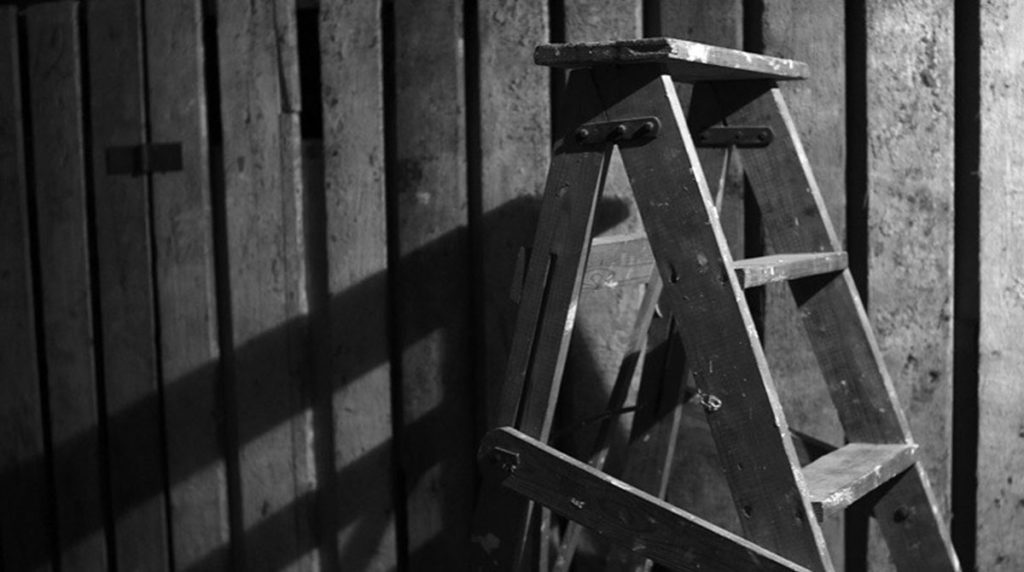
The painter Nicole Eisenman uses a ladder to get at the high parts of the paintings she is working on. This time it was a 6 foot x 10 foot composition called “Destiny Riding Her Bike.”
“Going up and down the ladder all day is really hard work,” she told the writer for a New Yorker profile. I had a few thoughts. One of the figures Eisenman was painting from her ladder was a person falling off a ladder, so her experience in painting this person—the steps she had to take, the work she did—was giving her insight, if only in confirming what she already knew but also by enlarging her understanding. It would be as if I wrote about being assaulted while someone held the kitchen paring knife to my neck. “Yes, it’s true, this is scary,” I might think, or “Scary though it is, you can still feel the chill of the porcelain blade and see a pearly shimmer from the corner of your eye!” The details I’d notice and write about under threat could be different in so many ways from what I’d only imagine without the experience. Likewise, the painting of a tumble from a ladder is bound to be different once you’ve climbed a ladder and felt the wobble and feared a fall. Experience and imagination tell different tales. The effort to tell a story becoming part of the story is reminiscent of a self-fulfilling prophecy, in which the attempt to avoid a prophecy is what makes it come true.
The best-known example of this might be in Sophocles’s Oedipus the King, but the one that sprang to mind for me was the Mesopotamian folktale, “Appointment in Samarra,” about a servant who one day in the market sees Death make a threatening gesture. Filled with fear, the servant borrows his master’s horse and rides all the way to Samarra to escape. Later that day, his master takes a stroll through the market and, seeing Death, asks why she’d made the threatening gesture. Death, in Somerset Maugham’s retelling, answers, “Not threatening—just surprised at seeing him here, because I have an appointment with him tonight in Samarra.” Poor man. As he learned in Samarra, his flight from death was just a stage in the journey toward death. We are not outside our story, looking in, like an omniscient narrator, but instead we are part of our story, ever and blindly constructing it, influenced by the story so far. It’s no wonder the steps we take toward one outcome often lead us to a different one.
But steps we must take because life is not lived in perfect repose, as Eisenman, an exercise fanatic and a former triathlon competitor, knows. So does another artist written about recently in The New Yorker, the graphic memoirist Alison Bechdel. She, like Eisenman, is also a serious exercise addict, and exercise is the subject of her work, The Secret to Superhuman Strength. For Bechdel, physical exertion, including running, is a search for transcendence. I had a friend once who every time running came up in the conversation asserted that running was for cowards. “What are you running from?” he’d ask, and I would lamely say I wasn’t running away but toward, though I could never name the goal. According to the article on Bechdel, that goal for her is a respite from ego. Her work describes moments when she seems to be above or outside her life, such as on the bank of a river, or at the top of a ski slope. Taking the ski run or jumping into the water is sublime surrender. But maybe my friend was right, in that running toward something is running away from the absence of it. Maybe any running at all is dissatisfaction with fate. Like the servant in the story, however, one tries to avoid certain fates for as long as possible.
It did the servant no good to run, though, because sometimes, as in a loop, away from and toward are the same. In climbing a ladder, too, you must either come back down the same way you went up or return to earth some other way, possibly through a fall. No one lives for long in the clouds, or for that matter at the top of the slope or on the bank of the river. If only we could manage contradictory desires by living in the clouds with our feet on the ground! To climb the ladder without risk, have our cake and eat it too, be born but not die, to live without pain.
Managing the contradictions is often difficult or even impossible in life, but easier in art, with its freedoms and pleasures. Eisenman is a case in point. In a single painting, she will have different perspectives. Or think of writers employing more than one point of view or shifting between distances in a single point of view.
And maybe easier because of art, when it’s therapy, as John Updike says of Remembrances of Things Past, “composed as an act of personal salvation.” Think of Alice Munro’s narrator in the story “Hired Girl,” saved by a book given to her as a parting gift at the end of a summer. She opens it randomly and says, “I felt as if I had just been rescued from my life … and no shame of my nature or condition could hold out against those flares of pleasure.” Art is good. “Art,” as Eisenman says, “is a creative, hopeful, optimistic position to work.” But it’s work. Especially from the top of a ladder, learning as you go. Especially when your painting shows that falls from high places happen, foretold or not.

